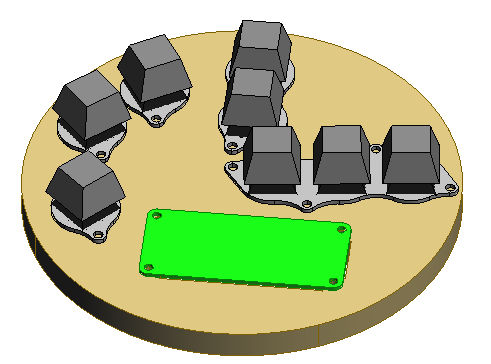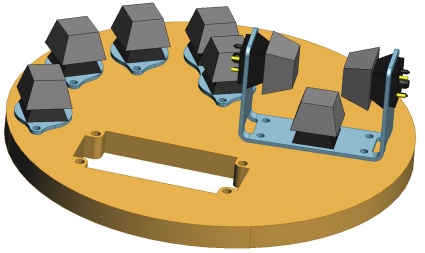The objective of this activity is a design for a keypad that can be tailored to the shape of an individual hand and can be made by anyone with a minimal ability in woodwork and can solder wires to pins. It is based on Cherry mx key switches which are mounted in laser cut metal plates. Technical drawings for these will be supplied and suppliers named, although there must be many of these in industrial estates all over the country.
These designs are based on a mounting board of 9mm mdf, readily available from DIY stores. A blank is cut out and holes are drilled corresponding to finger positions. I think there is an advantage in making the blank round, so that it can be orientated easily. The first one I made I cut roughly to shape and turned it to a disc with a lathe, but this is not critical. I determined the finger positions simply by resting my fingers in a position that felt relaxed and sufficiently spread out, and drawing round my fingertips. If you don’t get it right first time, remember mdf is cheap!
The intention is that the mounting plates would be screwed to the mounting board and the Cherry switches mounted in these. The result is intended to look like this:

The plan is to move on to improved thumb action by positioning the thumb keys so that they operate it three different directions:

Story so far
The intention of course it that the keys in the above figures would be connected to a Raspberry Pi 0 attached to the mounting board in the position shown.
So far I have not sourced the mounting plates and I only have the Cy-Key electronics to connect the keys to. I found that the Cherry key switch would firmly wedge into a 21mm diameter hole in the MDF board. I have connected the keys with a length of ribbon cable terminated with an insulation displacement connector which can plug into its opposite mounted on the electronics board.
Mar 2022
Since I wrote the above in June 2020 I have been concentrating on designing a 3-D printed device using reed switches. This looks like a much more elegant approach.
